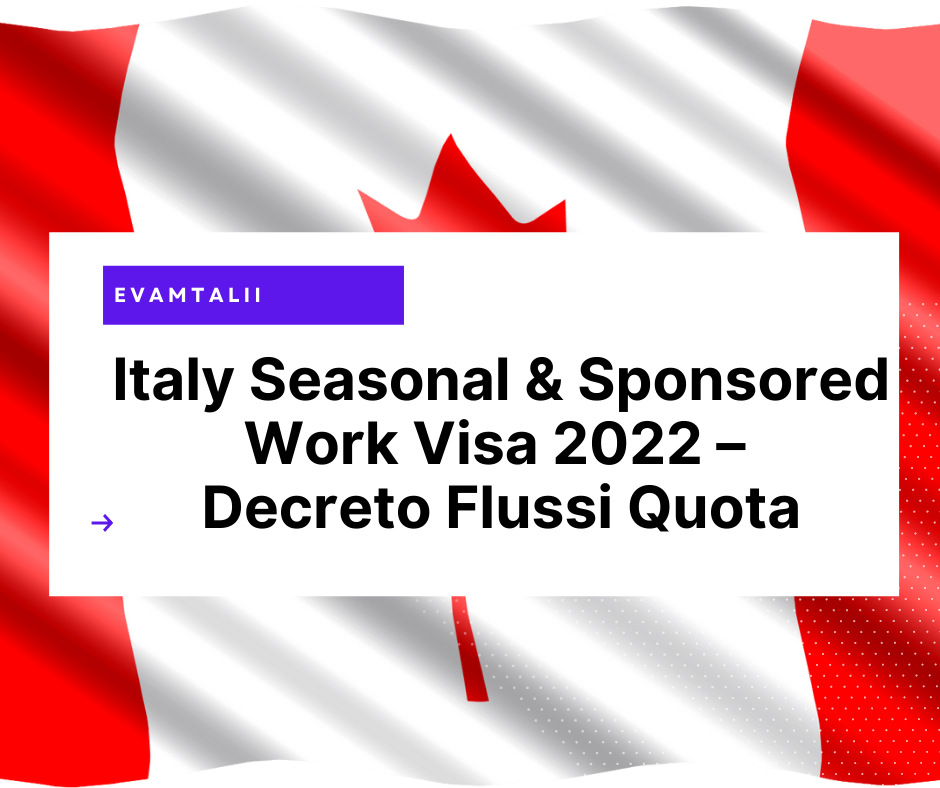Italy opened its work visa scheme for 2022 under Italy’s ‘Decreto Flussi’, i.e., (loosely translated as ‘flows decree’ i.e., an annual quota of how many people can enter Italy from outside the European Economic Area (EEA) to work) with an announcement of the opening date for submission of application for Italy work visa applications 2022 for both seasonal and non-seasonal workers.
Italy’s seasonal work visa decreto flussi is also sponsored visa. This means that there should be an employer/company in Italy willing to give you a job and sponsor your Italy work visa application.
Unlike most other countries, the Italian government usually puts a yearly limit on the number of work permits / non- EEA citizens legally allowed to move to Italy for work in any given year.
This week, the Italian government published the 21 December 2021 2022decree of the President of the Council of Ministers in the Official Gazette of 17 January 2022, setting the maximum number of decreto flussi to 69,700 workers, up from 30,000 in 2021. This is largely attributed to a shortage of skilled and unskilled workers and specialists in nearly all economic areas, but especially in the agriculture and hospitality sectors.
What's Covered in This Article
Where / how to find seasonal sponsored jobs in Italy
- Create an free account and register your CV/resume on online job search websites for Italy seasonal jobs:
- Ask your friends and/or relatives in Italy to help you to find an employer from Italy willing to offer you a job.
- Consider going through reputable recruitment agencies working in Italy
- Check out online Italian newspapers.
Decreto Flussi 2022 quota
Decreto Flussi quota for seasonal workers 2022
The 2022 Decree (Decreto Flussi) allows 42,000 spaces for seasonal workers from the following 31 nationalities:
- Albania,
- Algeria,
- Bangladesh,
- Bosnia-Herzegovina,
- Korea (Republic of Korea),
- Ivory Coast,
- Egypt,
- El Salvador,
- Ethiopia,
- Philippines,
- Gambia,
- Ghana,
- Japan,
- Guatemala,
- India,
- Kosovo,
- Mali,
- Morocco,
- Mauritius,
- Moldova,
- Montenegro,
- Niger,
- Nigeria,
- Pakistan,
- Republic of North Macedonia,
- Senegal,
- Serbia,
- Sri Lanka,
- Sudan,
- Tunisia,
- Ukraine.
Of these, 14,000 are for agricultural jobs, by the following professional employer organizations:
- CIA
- Kadiretti
- Configuration
- Cover
- Alliance of cooperatives (includes Lega delle Cooperative and Confcooperative).
Quota for non-seasonal and self employment
27,000 are reserved for non-seasonal and self-employed workers.
Among these:
-
- 20,000 are reserved for non-seasonal subordinate workers in the road transport, construction and tourism-hotel sectors for citizens of countries that have signed or are about to sign cooperation agreements in migration matters with Italy.
- 7,000 under the decree are reserved for those who need to convert a residence permit (permesso di soggiorno) held for other reasons, such as study, into a residence permit for work.
- 100 for workers from Venezuela of Italian origin “as long as at least one of their parents up to the third degree of direct ancestry”.
- 100 for foreign workers who have completed training and education in their country of origin
- 500 reserved for self-employed workers, as has been the case in previous years.
- Other categories include “artists of clear fame or of high and well-known professional qualification”.
- The remaining 17,000 are reserved for workers who are citizens of:
- Albania,
- Algeria,
- Bangladesh,
- Bosnia – Herzegovina,
- Korea (Republic of Korea),
- Ivory Coast,
- Egypt,
- El Salvador,
- Ethiopia,
- Philippines,
- Gambia,
- Ghana,
- Japan,
- Guatemala,
- India,
- Kosovo,
- Mali,
- Morocco,
- Mauritius,
- Moldova,
- Montenegro,
- Niger,
- Nigeria,
- Pakistan,
- Republic of North Macedonia,
- Senegal,
- Serbia,
- Sri Lanka,
- Sudan,
- Tunisia,
- Ukraine.
Decreto Flussi 2022 opening dates
2022 Italy work permit applications can be sent starting from:
- 9:00 am on January 27, 2022 for the hiring of non-seasonal workers, for self-employed workers and for conversions.
- 9:00 am on 1 February 2022 for the hiring of seasonal workers.
Applications can be submitted until March 17, 2022 and will be processed by the immigration office chronologically in the order in which they were received.
This means that you must start the visa application process as soon as possible since most quotas fill up within a few days of opening.
Any applications arriving after the quota is filled, or which are completed with errors, are rejected, and you can’t apply again in the same year.
As a non-EEA citizen, you need three main documents to live and work in Italy:
- a work permit (nulla osta),
- a work visa (visto) – must be done before you leave for Italy.
- a residence permit (permesso di soggiorno) – within 8 days of arriving in Italy.
If your work permit application is successful, you can then apply for your Italian visa.
Note: The nulla osta is valid for six months. This means that you must enter Italy and apply for the residence permit within that six-month period.
How do you apply for Italy work permit Decreto Flussi 2022?
Decreto Flussi 2022 apply links
Application links and the forms are available here.
Begin the application process by applying for the Italy work permit (nulla osta). You can access the application form here.
For seasonal and non-seasonal jobs work permit, only the employer can apply for you, while for the self-employed and conversions, you as the applicant must complete the process yourself.
As usual, the necessary requirement for the compilation and submission of applications is online via the Interior Ministry’s website and requires you to have an Italian e-ID aka called SPID, the Sistema Pubblico di Identità Digitale or ‘Public Digital Identity System’, if possible, using the same email address used for the SPID identity as the username.
For individuals, your SPID credentials are a single username and password that you can use to access Italian government services online, without having to go to an agency in person or show physical ID. Any adult living in Italy can apply for an SPID, provided they have a codice fiscale (tax code) and a valid Italian ID card.
On the application form, you will need to include details of where you’ll live in Italy as well as necessary work documents such as a copy of the employment contract, a nulla osta, diplomas and certificates, proof of accommodation in Italy, sufficient funds, any relevant licenses, etc.
How to get an SPID?
Requesting your SPID is free of charge.
Getting your SPID involves a verification process that you may complete online or that might require an in-person visit to an accredited provider’s office.
The SPID isn’t managed by the Italian government but currently provided by nine approved providers, including the Poste Italiane:
- Choose a provider from this list here.
- Go to your chosen provider’s website and get started by entering your details and generating your login.
- Confirm your identity using government-issued ID and either a certified digital signature, a card reader or app, by completing a short interview via webcam or in person. The exact procedure varies by provider.
What documents do you need?
- an email address;
- a mobile phone number;
- a valid identity document (e.g. ID card, passport, driving license)
- either a tessera sanitaria (health card) or a codice fiscale card.




I submitted for seasonal work in February 2022 but until now no any update, Kindly do the needful for me and update me regarding my documents I am really grateful to you
I will mentioned my mail ID name
Regards,
Muhammad Aqdas
When will the visa date be announced?
And how many days are there to submit sponsor visa, please let me know
Im want to came italy
sponser visa.
Im bangladeshi work in Singapore ,
So how i apply please help me thanks…
Email: litonislam1982@gmail.com
It’s really helpful and each and everything is included very much appropriately…